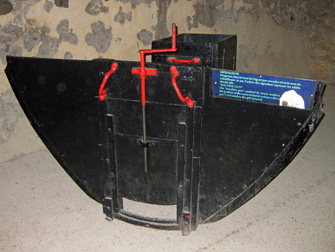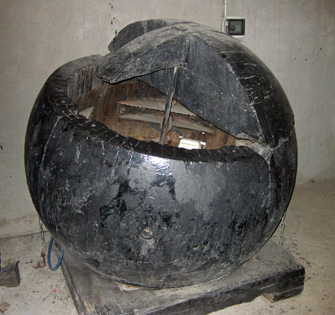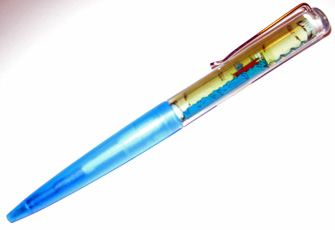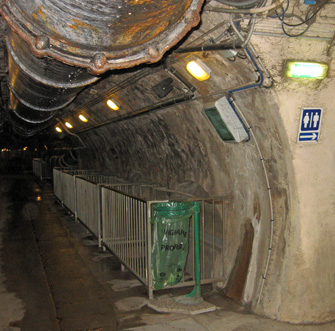
Yes, it stinks. On the opposite sides of both the Seine and the curatorial value spectrum from the Louvre is the Musée des Egouts de Paris – the Paris Sewer Museum. The display space is part of the city’s actual sewer system, so yeah, it smells bad, although I wouldn’t call it an unbearable stench. I wouldn’t host a picnic down there either, but it didn’t smell much worse than the livestock pavilion at the Salon de l’Agriculture, and, as I reported, people were gleefully eating lunch in there.
Paris’s sewers became, if not contained, the stuff of romantic legend when Victor Hugo set one of the most famous scenes from Les Misérables in them, the one where Jean Valjean goes on a trudge through the sludge carrying the wounded Marius on his back. Today, thanks to the museum, we can all follow in Hugo’s hero’s venerable footsteps. Not to mention the more numerous, although markedly less venerable, footsteps of the Teenage Mutant Ninja Turtles: one of the very first things you see is a photo of them visiting the Sewer Museum in 1992.
Figuring that since I had put so much into the system over the years it was time for me to get something out of it, I went to take the tour last week. The first section explains the water cycle in Paris, from the supply of cool, refreshing, healthful tap water to the disposal of… Well, the disposal of what you’re smelling as you learn about it. In fact, the exhibition explains this more than once, first on a series of posters, then in a 3D diorama and then once again in a series of banners, each taking you through the entire exact same process step by step.
So all right already, now I know: we get nice fresh ultra-top-quality water here in Paris. Water that’s famous for its purity and salubrious balance of calcium, magnesium and some other stuff that I didn’t note down but I’m sure is good for us. And after that water gets used to wash our hands, hair and dishes, or to flush our gutters, toilets and kidneys, then it gets gathered and filtered and aerated and deflocculated and disinfected and, big surprise, dumped into the Seine. Which, thanks to the aforementioned treatments, is not as polluted as it once was, if you’re inclined to believe everything you read on a poster in the Musée des Egouts. Two different displays make a big flushing deal of the fact that 29 species of fish can be found in the waters of our fair river, including perch, pike, gudgeon, zander, ablet, tench and carp. In case you fancy a little tench and chips, or perhaps a nice gudgeon-noodle casserole.
Speaking of zoology, yes, there are rats. The next non-human creatures you see on the tour after the Ninja Turtles and the fish are these rambunctious little rascals:

Apparently the Paris Sewer Authority maintains an attitude of cheerful acceptance toward the presence of rodents in the pipes. Not only do they have the above specimens stuffed as trophies, but the next section of the tour takes visitors along an open (and, fortunately, netted-over) working sewer main with lit-up (and, thankfully, grated over) side passages, and I could see their living, breathing descendants back in there, gamboling away. I suppose it’s actually a rather pleasant existence for a rat. At least you know where your next meal is coming from.
Beyond the vermin gallery, the exhibition traces the history of sewage disposal in Paris. Here I learned that the ancient Parisians didn’t settle along a river for nothing. From Roman times through the Middle Ages, the disposal of wastewater in Paris was simplicity itself. According to the displays, it posed no particular problem for the city’s early citizens to be using the Seine as both wellhead and latrine because the amount of filth dumped into it was low enough to allow the river to “biopurify” itself. I take this to mean that drinking water from the Seine wouldn’t kill you right away, leaving enough time for the Black Plague or Attila the Hun to show up, finish the job and get credit for it.
Essentially, sewage ran in the streets, somehow making its way back to the river, until the city’s first closed cloaca was built under Rue Montmartre in 1370. Thereafter, various administrations instituted various improvements from time to time. Louis XIV had a large-ish sewer built to serve the Right Bank. He left the Left Bank to get by with the Bièvre, the Seine tributary that runs (underground today) through the 5th and 13th arrondissements, and which remained in active use as a cesspit for households, tanneries, slaughterhouses and glue factories until well into the 20th century. Somewhere along the way, the Bièvre had acquired a reputation for being foul, noxious and malodorous (probably just one of those urban legends), and it was finally covered over in 1911.

Under Napoleon Bonaparte, the Parisian water supply and disposal systems were greatly improved. The emperor built the Canal d’Ourq, which brought unprecedented amounts of clean, fresh water into the city from the northeast. This was a boon for the people of Paris, but of course once all that water was no longer so clean and fresh, it had to be dealt with. Napoleon faced this challenge with the help of a heroic figure in the annals of muck: Emmanuel Bruneseau (1756-1826), whose fortuitously apt last name could be literally but ungrammatically translated as “Brownbucket.”
According to the museum’s blurb, Bruneseau “overcame superhuman difficulties to make a complete survey of the existing facilities between 1805 and 1812.” That’s a superhumanly long time to be wading around in excreta. Personally, I suspect that he may not have actually completed his survey (do you want to check his work?), but after eight years had had enough of the miasma and ran off to join Napoleon’s army in Moscow, practicing along the way how to say “Just shoot me!” in Russian.
Anyway, Napoleon, relying on Bruneseau’s say-so, did some expanding and upgrading, but it wasn’t until Baron Haussmann renovated Paris’s streets and boulevards in the mid-19th century that the city was given a complete sewer system worthy of the name. This was due to the efforts of another icon of elimination: Eugène Belgrand, the engineer who devised the network that still, with some extensions, serves the city today. It took a while, but by 1894 every street in town had its sewer, every building was connected to the system, and every sewer was large enough to be patrolled, the display says, by “a man of average height walking upright.” What the display doesn’t say is “except for the 45 percent of the time when he’s doubled over gagging.”
Belgrand’s system was considered radically visionary at the time. The museum describes it as a “totally new concept: having the wastewater discharged far downstream from Paris.” In other words, in more than 2,000 years of continuous, densely populated settlement, this had never occurred to anyone before. This absolutely astounds me. What were they thinking all that time?
“Hey, Lou, does this water taste funny to you?” “Yeah, kind of. Where’d you get it?” “The usual place, just below the dead horse market at Pont Neuf. You know — where they empty the chamber pots from the leper colony.” “Hmm. Must be something wrong with the bucket.”
Speaking of hygiene, another leitmotif in the tour is information about how they clean the sewers. There are at least five different displays devoted to the various manual devices, boats and dredges that they use, or used to use, to keep the mains clear and flowing. Some of them look exactly like you would expect:

While others are rather surprising:

Then I guess somebody has to clean the ball. And then somebody has to clean the ball cleaning equipment. And then somebody has to clean the ball cleaning equipment cleaning materials. And so on.
Interestingly, the operative euphemism at the Sewer Museum for the solid matter that somehow manages to collect in sewer mains (it’s the dangedest thing!) is “sand.” Not mud, not sludge, but “sand.” Not residue, soil, silt, gunk or goo, but “sand.” And it’s not an English mistranslation either, because the French word they use is sable. I can see the recruitment ads now: “Cleaning the sewers is like a day at the beach!”
Not surprisingly, after you get hired for the job, one of the first things you need is a pair of stout waterproof boots:

But it looks like they should be issuing wetsuits for some of the assignments:

My guess is that the guys who ream out the mains look down upon but secretly envy the people who run the museum’s gift shop. Yes, there’s a gift shop — who would want to go home without a nice keepsake from the sewer? You can get Egouts de Paris T-shirts (emblematic white only), baseball caps, fridge magnets, sliding tile puzzles and keychains. Also a Sewers of Paris carafe, which has to be the worst-advised choice in the history of branding (take a big swig!). But my favorite theme gifts are the plush toy rats for kids. This is where the “cheerful acceptance” of rodents mentioned in Part I of this article escalates into more of a “wholehearted embrace”:

And for aspiring Hugos, there’s a novelty ballpoint pen with a little figure of a sand-pushing boat that plies its way down the sewer when you tilt it:

And finally, yes, there are restrooms:

It may be purely for the sake of decorum, but they have lavatory facilities in the Sewer Museum, presumably with the shortest pipes in Paris. Also, these are probably the only restrooms in France, if not the world, with a sign on the door saying:
“Employees must not wash hands before returning to work.”
Okay, actually there’s no such sign. I’m sanding you.
The Musée des Égouts de Paris is located across from 93, quai d’Orsay on the Left Bank side of the Pont d’Alma. Click here for map.
Editor’s note: This article was originally published in Paris Update on May 31 and June 6, 2011.
Reader Becky Bove writes: “I was reminded of my first trip to Paris in the early ’70’s, when I was able to visit the sewers for 10 centimes. The sewer tour participants were marched down a set of steep steps and loaded into a small a wooden boat with chains attached and then towed by men in sturdy rubber boots who trudged alongside. The tour, which I have to believe appealed only to foreign tourists, was conducted entirely in French, of course. There were many interesting facts presented about the role of the sewers, some relating to the resistance during WWII. Several battered enameled street signs were proudly displayed. Your article brought back many fond memories, and I’d have to say the tour was worth every centime!”
© 2015 Paris Updat
FavoriteAn album of David Jaggard’s comic compositions is now available for streaming on Spotify and Apple Music, for purchase (whole or track by track) on iTunes and Amazon, and on every other music downloading service in the known universe, under the title “Totally Unrelated.”
Note to readers: David Jaggard’s e-book Quorum of One: Satire 1998-2011 is available from Amazon as well as iTunes, iBookstore, Nook, Reader Store, Kobo, Copia and many other distributors.
